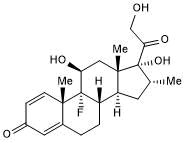Glucocorticoid Receptor Compounds: Small Molecules and Peptides
Glucocorticoid Receptor (GR), also known as NR3C1, is a member of the NR3 family of nuclear receptors. It mediates the physiological and pharmacological actions of glucocorticoids, including modulation of immune responses, mediation of stressor-induced adaptations, and regulation of metabolism. GR is composed of a N-terminal transactivation domain (NTD, amino acids [aa] 1-421), a central DNA-binding domain (DBD, aa 422-486), and a C-terminal ligand-binding domain (LBD, aa 528-777). A flexible region, termed hinge region, lies between the DBD and LBD (aa 487-527), two zinc finger motifs are found within the DBD (aa 421-441 and 457-476), and two nuclear localization sequences (NLS) lie at the junction of the DBD and hinge region, and within the LBD. Alternative splicing produces two isoforms, termed GR alpha and GR beta. GR alpha is the classic GR protein that mediates glucocorticoid actions.
Alternative translation initiation produces eight different GR alpha subtypes. GR beta does not bind to glucocorticoids. Instead, it appears to function as a dominant negative inhibitor to GR alpha. Unactivated GR alpha resides in cytoplasm. It exists as part of a large multi-protein complex that includes HSP90, HSP70/HSPA1A, p23, FKBP51, and FKBP52. Upon ligand binding, GR alpha undergoes a conformational change that results in the dissociation of the associated proteins, exposure of the two NLSs, and translocation of GR alpha into the nucleus. GR alpha subsequently binds to target genes via their zinc finger motifs to regulate their expression. GR alpha can also elicit rapid cellular responses via activating a number of signaling proteins including AKT, PI 3-Kinase, and MAPKs. Human GR alpha is 777 aa in length with a predicted molecular length of approximately 85.7 kDa. It shares 89% and 88% aa sequence identity with the mouse and rat orthologs, respectively.
4 results for "Glucocorticoid Receptor Compounds Small Molecules and Peptides" in Products
4 results for "Glucocorticoid Receptor Compounds Small Molecules and Peptides" in Products
Glucocorticoid Receptor Compounds: Small Molecules and Peptides
Glucocorticoid Receptor (GR), also known as NR3C1, is a member of the NR3 family of nuclear receptors. It mediates the physiological and pharmacological actions of glucocorticoids, including modulation of immune responses, mediation of stressor-induced adaptations, and regulation of metabolism. GR is composed of a N-terminal transactivation domain (NTD, amino acids [aa] 1-421), a central DNA-binding domain (DBD, aa 422-486), and a C-terminal ligand-binding domain (LBD, aa 528-777). A flexible region, termed hinge region, lies between the DBD and LBD (aa 487-527), two zinc finger motifs are found within the DBD (aa 421-441 and 457-476), and two nuclear localization sequences (NLS) lie at the junction of the DBD and hinge region, and within the LBD. Alternative splicing produces two isoforms, termed GR alpha and GR beta. GR alpha is the classic GR protein that mediates glucocorticoid actions.
Alternative translation initiation produces eight different GR alpha subtypes. GR beta does not bind to glucocorticoids. Instead, it appears to function as a dominant negative inhibitor to GR alpha. Unactivated GR alpha resides in cytoplasm. It exists as part of a large multi-protein complex that includes HSP90, HSP70/HSPA1A, p23, FKBP51, and FKBP52. Upon ligand binding, GR alpha undergoes a conformational change that results in the dissociation of the associated proteins, exposure of the two NLSs, and translocation of GR alpha into the nucleus. GR alpha subsequently binds to target genes via their zinc finger motifs to regulate their expression. GR alpha can also elicit rapid cellular responses via activating a number of signaling proteins including AKT, PI 3-Kinase, and MAPKs. Human GR alpha is 777 aa in length with a predicted molecular length of approximately 85.7 kDa. It shares 89% and 88% aa sequence identity with the mouse and rat orthologs, respectively.
Anti-inflammatory glucocorticoid
| Chemical Name: | (11β,16α)-9-Fluoro-11,17,21-trihydroxy-16-methyl-pregna-1,4-diene-3,20-dione |
| Purity: | ≥98% (HPLC) |
Adrenal glucocorticoid; immunosuppressant
| Chemical Name: | 11β,17α,21-Trihydroxypregn-4-ene-3,20-dione |
| Purity: | ≥98% (HPLC) |
Synthetic glucocorticoid; anti-inflammatory and chemopreventive
| Chemical Name: | (11β,16α)-16,17-[Butylidenebis(oxy)]-11,21-dihydroxypregna-1,4-diene-3,20-dione |
| Purity: | ≥98% (HPLC) |
Dexamethasone synthesized to Ancillary Material Grade
| Chemical Name: | (11β,16α)-9-Fluoro-11,17,21-trihydroxy-16-methylpregna-1,4-diene-3,20-dione |
| Purity: | ≥98% |




